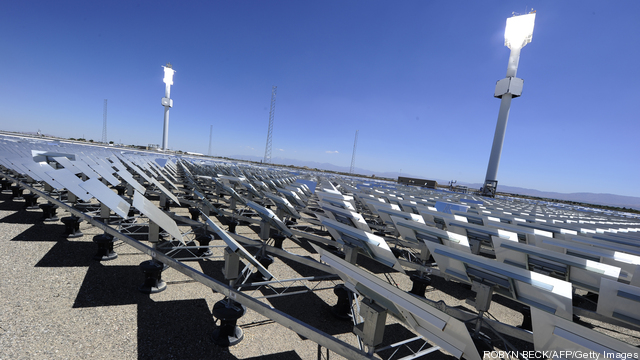
Two Israeli exhibition staffers next to solar panels at a stand at the EnergyTech international exhibition on solar, wind and green technologies in the Israeli coastal city of Tel Aviv.
The Middle East is being eyed for a solar revolution by the Chinese owner of more than 40% of Israel’s solar photovaltaic panels in a new twist on the energy sector’s international roots.
Currently the largest producer of solar panels in the world, China-based Suntech has long been eyeing the oil-rich Middle Eastern market as a critical region for energy transformation. As oil prices skyrocket, many Middle Eastern countries are opting to sell their oil and produce electricity from other sources – including solar – for domestic use.
But the Israeli market has been a unique business opportunity for Suntech because of the plethora of high-tech and IT companies in the country’s “Silicon Wadi” that are innovating unique solar solutions.
Suntech signed a 10 million NIS (approximately $2.7 million) contract in January with Israel’s Tel Aviv-based Enerpoint for the company’s SuperPoly solar system that improves panel operating efficiency in extremely hot and sunny climates like Israel and the Middle East. The companies say that contract, which was signed for the first quarter of 2012, could be extended for the remainder of the year.
And while Suntech has done most of its business in Israel through large local solar companies like Arava Power in the south and Solarit Doral in the north, Suntech Communications Supervisor for the Asia Pacific, Middle Eastand Africa (APMEA) regions Ryan Ulrich told Breaking Energy that Israel has proved a very comfortable place for the company to do business.
“In Israel things are much more open: access to relevant decision makers, access to the media is much easier than in other markets,” Ulrich said.
A Holy Land History
Ulrich said Israel has been a key market for Suntech since 2008 when the company joined with Solarit Doral to build a 50 kW rooftop solar installation in Katzrin, located in Israel’s Golan Heights mountain range. Since then, Suntech provided the panels to Arava Power for Israel’s first utility-scale solar project, a 4.95 MW solar array in Kibbutz Ketura. Keep reading →

Like your typical garden flower, this tulip captures heat from the sun for energy. But unlike most flowers, this one is 115 feet tall and uses a combination of gas and mirrored heliostats to spin a gas turbine that creates electricity.
AORA‘s concentrated solar power (CSP) systems – designed in southern Israel where sunlight is abundant and water is scarce – uses pressurized air, rather than water, to spin a conventional gas turbine. If the air momentarily cools, from cloud cover for example, the tower automatically reroutes the air through a combustion chamber that can use anything from biogas and methane to natural gas and diesel to heat the air and spin the turbine. Keep reading →

The State Department on Friday released its final environmental assessment of the Keystone XL, removing a major barrier to the construction of the 1,700 mile oil pipeline, which would stretch from Alberta, Canada, to the Gulf Coast.
In a report consistent with the agency’s earlier findings, the final Environmental Impact Statement found the proposed pipeline would have “no significant impact” to the vast majority of resources along the pipeline corridor, and suggested moving forward on the project with limited modifications. Keep reading →





